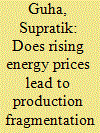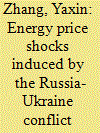|
|
|
Sort Order |
|
|
|
Items / Page
|
|
|
|
|
|
|
| Srl | Item |
| 1 |
ID:
096643


|
|
|
|
|
| Publication |
2010.
|
| Summary/Abstract |
The topic of this article is the analysis of the interplay between daily carbon, electricity and gas price data with the European Union Emission Trading System (EU ETS) for CO2 emissions. In a first step we have performed Granger causality tests for Phase I of the EU ETS (January 2005 until December 2007) and the first year of Phase II of the EU ETS (2008). The analysis includes both spot and forward markets-given the close interactions between the two sets of markets. The results show that during Phase I coal and gas prices, through the clean dark and spark spread, impacted CO2 futures prices, which in return Granger caused electricity prices. During the first year of the Phase II, the short-run rent capture theory (in which electricity prices Granger cause CO2 prices) prevailed. On the basis of the qualitative results of the Granger causality tests we obtained the formulation testable equations for quantitative analysis. Standard OLS regressions yielded statistically robust and theoretically coherent results.
|
|
|
|
|
|
|
|
|
|
|
|
|
|
|
|
| 2 |
ID:
097477


|
|
|
|
|
| Publication |
2010.
|
| Summary/Abstract |
The topic of this article is the analysis of the interplay between daily carbon, electricity and gas price data with the European Union Emission Trading System (EU ETS) for CO2 emissions. In a first step we have performed Granger causality tests for Phase I of the EU ETS (January 2005 until December 2007) and the first year of Phase II of the EU ETS (2008). The analysis includes both spot and forward markets-given the close interactions between the two sets of markets. The results show that during Phase I coal and gas prices, through the clean dark and spark spread, impacted CO2 futures prices, which in return Granger caused electricity prices. During the first year of the Phase II, the short-run rent capture theory (in which electricity prices Granger cause CO2 prices) prevailed. On the basis of the qualitative results of the Granger causality tests we obtained the formulation testable equations for quantitative analysis. Standard OLS regressions yielded statistically robust and theoretically coherent results.
|
|
|
|
|
|
|
|
|
|
|
|
|
|
|
|
| 3 |
ID:
125793


|
|
|
|
|
| Publication |
2013.
|
| Summary/Abstract |
To establish a reasonable system and mechanism for Chinese energy prices, we use the Granger causality test, Hodrick-Prescott (HP) filter and time difference analysis to research the pricing relationship between Chinese and international energy prices. We find that Chinese and international crude oil prices changed synchronously while Chinese refined oil prices follow the changes of international oil prices with the time difference being about 1 month to 2 months. Further, Australian coal prices Granger causes Chinese coal prices, and there is a high correlation between them. The U.S. electricity price is influenced by the WTI crude oil price, the U.S. gasoline price and the HenryHub gas price. Due to the unreasonable price-setting mechanism and regulation from the central government, China's terminal market prices for both electricity and natural gas do not reflect the real supply-demand situation. This paper provides quantitative results on the correlation between Chinese and international energy prices to better predict the impact of international energy price fluctuations on China's domestic energy supply and guide the design of more efficient energy pricing policies. Moreover, it provides references for developing countries to improve their energy market systems and trading, and to coordinate domestic and international energy markets.
|
|
|
|
|
|
|
|
|
|
|
|
|
|
|
|
| 4 |
ID:
162930


|
|
|
|
|
| Summary/Abstract |
Energy and heat cross-subsidies are common in developing and transitioning countries, but the distributional and efficiency impacts of these policies (and reform) are largely unknown. In Post-Soviet countries such as Belarus, revenues from an industrial tariff on electricity are used to cross-subsidize heating for households. We analyze the distributional impacts of cross-subsidy reform with both input output methods and a calibrated static computable general equilibrium (CGE) model with heterogeneous households based on a household consumption survey. On average, GDP gains of roughly a quarter of a percent are computed across model runs which reduce taxes and subsidies from cross-subsidization. Reducing household heating subsidy rates equally across income groups is found to be regressive. Poorer households are overly-burdened due to higher heating expenditures while richer households enjoy gains from cheaper market prices for goods. The GDP gains are even larger when the tax rates are structured to create a distributionally-neutral reform.
|
|
|
|
|
|
|
|
|
|
|
|
|
|
|
|
| 5 |
ID:
190834


|
|
|
|
|
| Summary/Abstract |
How does the price of energy affect the extent of production fragmentation in India’s manufacturing industries? The prevailing literature has engaged with production fragmentation and trade in middle products for a long time, but the relationship between energy prices and production fragmentation is less understood. This article deals with firm-level panel data of India’s manufacturing industries between 2005 and 2018 to estimate the impact of rising energy prices on the outsourcing decisions/production organization of the manufacturing firms. The article also uses a number of covariates, including wages, welfare expenses, sales, profit after tax, dividend rate, foreign exchange earnings and an interaction term between energy prices and foreign exchange earnings. The empirical results of this article indicate that larger firms tend to outsource production in part to smaller firms in order to cope with rising energy prices and keep their profitability intact. Static and dynamic panel estimates with a variety of robustness analyses support the main conjectures.
|
|
|
|
|
|
|
|
|
|
|
|
|
|
|
|
| 6 |
ID:
150869


|
|
|
|
|
| Summary/Abstract |
The profitability of nuclear power plant investment is largely determined by the construction duration, which directly impacts discounted cash flows, debt and interest payments, as well as variable costs, such as labor. This paper analyzes the key drivers of construction duration using survival models. We focus especially on the strategic expectation formation of private and public utilities engaging in such highly risky megaprojects. Using a balanced dataset of explanatory variables and the IAEA/PRIS dataset of reactor construction starts between 1950 and 2013 we find that the expectation of rising oil prices and higher economic growth, along with the higher per capita GDP of a country tend to reduce the time needed to grid connection. We also identify the reactor models with the fastest construction duration.
|
|
|
|
|
|
|
|
|
|
|
|
|
|
|
|
| 7 |
ID:
150735


|
|
|
|
|
| Summary/Abstract |
We estimate energy expenditure for the US and world economies from 1850 to 2012. Periods of high energy expenditure relative to GDP (from 1850 to 1945), or spikes (1973–74 and 1978–79) are associated with low economic growth rates, and periods of low or falling energy expenditure are associated with high and rising economic growth rates (e.g. 1945–1973). Over the period 1960–2010 for which we have continuous year-to-year data for control variables (capital formation, population, and unemployment rate) we estimate that, statistically, in order to enjoy positive growth, the US economy cannot afford to spend more than 11% of its GDP on energy. Given the current energy intensity of the US economy, this translates in a minimum societal EROI of approximately 11:1 (or a maximum tolerable average price of energy of twice the current level). Granger tests consistently reveal a one way causality running from the level of energy expenditure (as a fraction of GDP) to economic growth in the US between 1960 and 2010. A coherent economic policy should be founded on improving net energy efficiency. This would yield a “double dividend”: increased societal EROI (through decreased energy intensity of capital investment), and decreased sensitivity to energy price volatility.
|
|
|
|
|
|
|
|
|
|
|
|
|
|
|
|
| 8 |
ID:
087109


|
|
|
|
|
| Publication |
Amsterdam, Elsevier Science Publishers, 1995.
|
| Description |
xxviii, 372p.
|
|
|
|
|
|
|
|
|
|
|
|
Copies: C:1/I:0,R:0,Q:0
Circulation
| Accession# | Call# | Current Location | Status | Policy | Location |
| 029161 | 333.79/WAS 029161 | Main | On Shelf | General | |
|
|
|
|
| 9 |
ID:
191406


|
|
|
|
|
| Summary/Abstract |
The significant spike in global energy prices induced by the Russian-Ukrainian (RU) conflict is perceived as highly uncertain that may rise household living costs and adversely affect Sustainable Development Goals such as poverty elimination. However, the impacts on human wellbeing are entirely obscured by conventional economic analyses. Using the input-output price model and a human needs framework, we assess the impact of energy price shocks caused by the RU conflict on eight dimensions of human needs in 49 countries/regions. Our findings show that the non-material dimension Creation and the material dimension Protection are the most affected human needs globally, with declines of 3.7%–8.5% and 3.6%–8.4%, respectively. Households in BRICS countries are hit hardest on these human needs (2.0-2.2 times the global average) owing to higher price increases and higher energy-dependent consumption patterns. The human need satisfaction of low-income groups is not only severely affected, but also the poorer the country in which they reside, the more serious the decline of their satisfaction, while there is no such problem for higher income groups. Our findings underscore the need to consider both material and frequently overlooked non-material dimensions of wellbeing when designing targeted policies to protect the vulnerable from energy price shocks.
|
|
|
|
|
|
|
|
|
|
|
|
|
|
|
|
| 10 |
ID:
132771


|
|
|
|
|
| Publication |
2014.
|
| Summary/Abstract |
We use a quantile regression framework to investigate the impact of changes in crude oil prices, natural gas prices, coal prices, and electricity prices on the distribution of the CO2 emission allowance prices in the United States. We find that: (i) an increase in the crude oil price generates a substantial drop in the carbon prices when the latter is very high; (ii) changes in the natural gas prices have a negative effect on the carbon prices when they are very low but have a positive effect when they are quite high; (iii) the impact of the changes in the electricity prices on the carbon prices can be positive in the right tail of the distribution; and (iv) the coal prices exert a negative effect on the carbon prices.
|
|
|
|
|
|
|
|
|
|
|
|
|
|
|
|
| 11 |
ID:
142923


|
|
|
|
|
| Summary/Abstract |
An interview with Ambassador Richard Morningstar, founding director of the Global Energy Center at the Atlantic Council, is presented. He discusses the reasons behind the declining energy prices, the current and future economic and political impacts of a decline in energy prices, and issues arising in the nexus of energy and geopolitics, in light of advances in renewable energy and developments in global climate change.
|
|
|
|
|
|
|
|
|
|
|
|
|
|
|
|
| 12 |
ID:
114323


|
|
|
|
|
| Publication |
2012.
|
| Summary/Abstract |
Energy prices in Iran have traditionally been heavily subsidized by the Government, and as a result, energy consumption per capita in Iran is close to the European Union level. The welfare effects of efforts to raise energy prices closer to world levels are examined in this paper. Reform of energy prices is an important element of the "Economic Reform Plan" (2010-2014) for Iran. We first analyze the relationship between energy consumption, energy and non-energy prices by estimating the household expenditure function. The results show that a higher energy prices will decrease energy consumption by Iranian households. Second, we evaluate the impact of a rise of energy prices on the household welfare by measuring the compensating variation (CV) in five steps with a compensating payment. The results show that Iranian household welfare will increase with a 100% or 200% rise in energy prices, if the government pays 20%, 30% or 50% of the $20 billion income resulting from removing energy subsidies. While, in contrast, Iranian household welfare will decrease with a 400% and 500% rise in energy prices, if the government payment is 20% or 30% of $20 billion income.
|
|
|
|
|
|
|
|
|
|
|
|
|
|
|
|
| 13 |
ID:
150625


|
|
|
|
|
| Summary/Abstract |
European Union carbon emissions allowances (EUA) price fluctuations can affect electricity companies' stock market values as these oscillations may change firms' profitability and thus investors' decisions. This outcome can differ not only contingent on the EU ETS Phase, but also on firms' generation mix. Moreover, stock markets may react differently to EUA increases in comparison to decreases, thus asymmetrically.
|
|
|
|
|
|
|
|
|
|
|
|
|
|
|
|
| 14 |
ID:
149863


|
|
|
|
|
| Summary/Abstract |
While the shale revolution was largely a US’ affair, it affects the global energy system. In this paper, we look at the effects of this spectacular increase in natural gas, and oil, extraction capacity can have on the mix of primary energy sources, on energy prices, and through that on internal political stability of rentier states. We use two exploratory simulation models to investigate the consequences of the combination of both complexity and uncertainty in relation to the global energy system and state stability. Our simulations show that shale developments could be seen as part of a long term hog-cycle, with a short term drop in oil prices if unconventional supply substitutes demand for oil. These lower oil prices may lead to instability in rentier states neighbouring the EU, especially when dependence on oil and gas income is high, youth bulges are present, or buffers like sovereign wealth funds are too limited to bridge the negative economic effects of temporary low oil prices.
|
|
|
|
|
|
|
|
|
|
|
|
|
|
|
|
| 15 |
ID:
126537


|
|
|
|
|
| Publication |
2013.
|
| Summary/Abstract |
In China, most energy prices are controlled by the government and are under-priced, which means energy subsidies existing. Reforming energy subsidies have important implications for sustainable development through their effects on energy price, energy use and CO2 emission. This paper applies a price-gap approach to estimate China's fossil-fuel related subsidies with the consideration of the external cost. Results indicate that the magnitude of subsidies amounted to CNY 1214.24 billion in 2008, equivalent to 4.04% of GDP of that year. Subsidies for oil products are the largest, followed by subsidies for the coal and electricity. Furthermore, an input-output model is used to analyze the impacts of energy subsidies reform on different industries and general price indexes. The findings show that removal of energy subsidies will have significant impact on energy-intensive industry, and consequently push up the general price level, yet with a small variation. Removing oil products subsidies will have the largest impact, followed by electricity, coal and natural gas. However, no matter which energy price increases, PPI is always the most affected, then GDP deflator, with CPI being the least. Corresponding compensation measures should be accordingly designed to offset the negative impact caused by energy subsidies reform.
|
|
|
|
|
|
|
|
|
|
|
|
|
|
|
|
| 16 |
ID:
117329


|
|
|
|
|
| Publication |
2013.
|
| Summary/Abstract |
Deregulated energy markets were founded on the Merchant Power Producer, a stand-alone generator that sold its production to the spot and short-term forward markets, underpinned by long-dated project finance. The initial enthusiasm that existed for investment in existing and new merchant power plant capacity shortly after power system deregulation has progressively dissipated, following an excess entry result. In this article, we demonstrate why this has become a global trend. Using debt-sizing parameters typically used by project banks, we model a benchmark plant, then re-simulate its performance using live energy market price data and find that such financings are no longer feasible in the absence of long-term Power Purchase Agreements.
|
|
|
|
|
|
|
|
|
|
|
|
|
|
|
|
| 17 |
ID:
136251


|
|
|
|
|
| Summary/Abstract |
China and the United States of America (US) are developing renewable energy concurrently. In this paper, we seek the opportunities for potential cooperation between these two countries based on the analysis of annual economic data. A mathematical model has been established to characterize correlations among GDP, carbon dioxide emissions, energy prices and the renewable energy cooperation index. Based on statistical analyses, such cooperation can promote economic development, reduce carbon dioxide emissions, improve the environment and realize green growth. If US monetary and technology resources and Chinese markets are combined, benefits can be mutually gained.
|
|
|
|
|
|
|
|
|
|
|
|
|
|
|
|
| 18 |
ID:
094242


|
|
|
|
|
| Publication |
2010.
|
| Summary/Abstract |
Renewable energy can become the major energy supply option in low-carbon energy economies. Disruptive transformations in all energy systems are necessary for tapping widely available renewable energy resources. Organizing the energy transition from non-sustainable to renewable energy is often described as the major challenge of the first half of the 21st century. Technological innovation, the economy (costs and prices) and policies have to be aligned to achieve full renewable energy potentials, and barriers impeding that growth need to be removed. These issues are also covered by IPCC's special report on renewable energy and climate change to be completed in 2010. This article focuses on the interrelations among the drivers. It clarifies definitions of costs and prices, and of barriers. After reviewing how the third and fourth assessment reports of IPCC cover mitigation potentials and commenting on definitions of renewable energy potentials in the literature, we propose a consistent set of potentials of renewable energy supplies.
|
|
|
|
|
|
|
|
|
|
|
|
|
|
|
|
| 19 |
ID:
150732


|
|
|
|
|
| Summary/Abstract |
The goal of this paper is to provide new insights to elucidate the inconclusive results from the Environmental Kuznets Curve (EKC) empirical literature. For the first time in empirical literature, an econometric analysis includes the relative prices for several energy sources. The paper provides strong evidence on the relevance of energy prices to CO2 emissions. Accordingly, one reason for the lack of agreement in the EKC literature may be the absence of energy prices in empirical exercises. The presence of relative energy price changes in the econometric specification confirms a monotonic and positive relationship between CO2 and gross domestic product (GDP). Therefore, we may conclude that there is a decoupling process but without reaching any turning point on that relationship. The policy implications are straightforward. Direct climate action by policy makers is required to break the positive relationship between CO2 and GDP. That conclusion has been reinforced by the reduction of energy prices since the middle of 2014. Otherwise, the trend in energy prices may reverse the relative decarbonisation processes accounted for in recent years in major developed countries.
|
|
|
|
|
|
|
|
|
|
|
|
|
|
|
|
| 20 |
ID:
176759


|
|
|
|
|
| Summary/Abstract |
The assessment of fuel poverty in mainland France is based mainly on data provided by the French national housing survey. However, the last two surveys date from 2006 and 2014. To understand the change in the number of fuel poverty households, we have developed a microsimulation tool that takes into account the three predominant factors in the notion of fuel poverty, that is, household resources, energy prices and dwelling quality. Our tool includes three multiple linear models for estimating the following: 1. disposable income; 2. energy expenditure; and 3. the probability of performing a thermal renovation. We test our model with real values for variation in energy prices and variation in disposable income and a realistic number of housing renovations. The model is calibrated to the two last French national housing survey, matches the data very well and closely reproduces the number in fuel poverty in the 2012/2014 period. We not only evaluate fuel poverty in France in 2018 but also study the effects of variations in the unemployment rate, energy prices and number of thermal renovations.
|
|
|
|
|
|
|
|
|
|
|
|
|
|
|
|
|
|
|
|
|